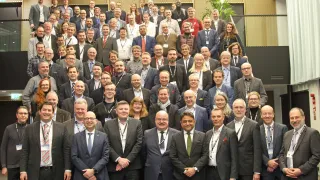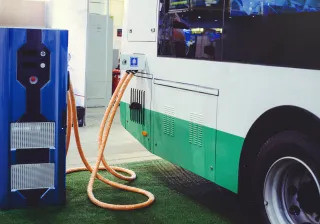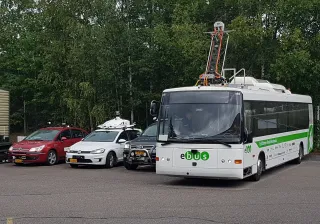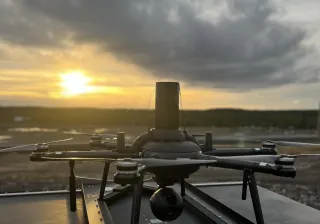In the future, drones will deliver parcels to your home and assist in farming and construction. These are some of the applications where developments will be rapid once European ground rules and safe airspace practices (U-space) are established for unmanned aircraft systems and future aircraft. Advancements in this field are driven, for instance, by the need to reduce emissions from transport and logistics and by the opportunities offered by digitalisation.
Written by Hannu Karvonen, Vadim Kramar, Timo Lind and Petri Mononen
On 26 January in Helsinki, VTT and Fintraffic hosted a meeting for the U-space Stakeholder Network, coordinated by EUROCONTROL. Munish Khurana from EUROCONTROL, the Coordinator of the network, timed this event to coincide with the day when the EU regulatory framework for the U-space came into force. The event also celebrated the Helsinki spirit since the Drones Helsinki Declaration launched the term U-space in 2017, as pointed out by Andrew Hately from EUROCONTROL.
U-space is a system of systems designed to ensure the safe operations of any number of future aircraft, such as drones. For these operations, geographical zones called U-space airspace are to be designated by the EU Member States. A range of U-space services relying on digital services and automation of functions designed to support safe, secure and efficient access to U-space airspace is also to be provisioned.
The U-space stakeholder event featured expert reviews of the recently published European Commission Drone Strategy 2.0 for a Smart and Sustainable Unmanned Aircraft Eco-System in Europe and U-space experiences from different countries. At the event, almost 160 participants from Europe and guests from the USA and Israel listened and debated vital U-space topics, discussed and agreed on future plans, and actively participated in the workshops.
The event highlights
After the hosts, Pasi Nikama from Fintraffic and Munish Khurana had opened the event, Joachim Lücking from the EC, DG Move, shared an update on the EU Drone Strategy 2.0. He highlighted the process conducted to develop the strategy and some future steps in implementing flagship items of the strategy. The members of the U-space network form a key stakeholder group, which can help in this implementation. Stephane Vaubourg from EASA continued on how the mood regarding U-space is now changing from thinking to doing. In practice, EASA is currently working with the member states to support the implementation of the U-space legislative framework into action.
The program continued with three speakers from Finland. Pertti Korhonen, the CEO of Fintraffic, was very enlightening regarding the advanced capacity and maturity of the digitalisation of Finland. In fact, Finland is the world’s number one on the Digital Economy and Society (DESI) index. However, Korhonen highlighted that the business model for the digitalisation infrastructure is a challenge for Finland as well: who actually pays for what and how?
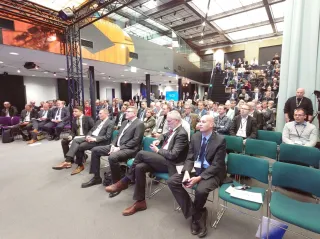
Timo Harakka, the Finnish Minister of Transport and Communications, highlighted that because of Finland’s geography, regional air mobility is of crucial importance. Therefore, the future use of drones to assist in essential services is very important for our country. Minister Harakka also emphasised that there is a need for a relevant centre of excellence in Finland, and appropriate funding for this type of innovation activity is required.
Finally, Petri Mononen from VTT highlighted some of the U-space-relevant research activities in Finland and challenged the status quo and the funding processes in Europe. In its projects, VTT focuses on several flagship actions of the EU Drone Strategy 2.0, including U-space implementation and civil-military drone synergies.
The workshops
After lunch, three workshops were organised in parallel. The workshops focused on the following topics:
- U-Space Concept of Operation
- Cyber security
- Synergies between civil, security and defence industry capabilities related to U-Space test centres
On the one hand, the outcomes of the workshops were generic enough to be forwarded to regulators, researchers, and policymakers. Conversely, the results were also concrete enough to put actions in place and bring some developments already in the following months.
The recording of the main parts of the U-space Stakeholder Network meeting and the U-Space Concept of Operation workshop is available on YouTube.
What’s next for U-space development?
Below are 5 steps identified in the event for further development of U-space:
- As the U-space regulation is now in force, all EU countries are working on their national implementations of the legislative framework.
- Commercially available U-space airspaces are expected to be opened in the future in all European countries, starting from some leading regions.
- U-Space Concept of Operation work will be further developed by the EU stakeholders after the CORUS-XUAM project, even though it is not yet decided how that will be organised.
- Cyber security in the domain is vital, and refining the current approach and using existing standards and requirements while identifying specific U-space gaps, which are yet to be covered, is needed.
- U-space test centres and areas form an assembly of stakeholders that require a dedicated arrangement.
In summary, the European Drone Strategy 2.0 opens a new era of Innovative Air Mobility in Europe, and the U-space legislative framework is one of the essential steps forward.
VTT will continue to contribute to the development of U-space, emerging technology aircraft, and different forms of air mobility. Please be in touch with us, and let’s do it together!
Main image: Miikka Hult




